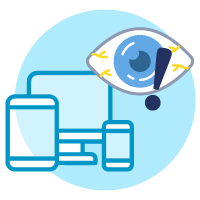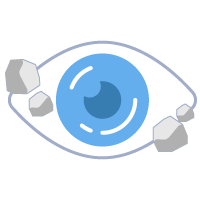


Dry Eye
乾眼症(也被稱為乾眼病)是全球最常見的眼部病症之一。 根據《全球衛生雜誌》¹ 的研究報告表示,在全球乾眼症的患病率可高達50%。乾眼症成因包括:長時間使用電腦子產品、配戴隱形眼鏡、年齡增長、荷爾蒙影響、服用某些藥物、外在環境等。若發現有眼睛持續乾澀、眼癢、畏光等症狀,如果置之不理有可能令眼角膜磨損,造成炎症同潰瘍,出現視力下降,嚴重患者甚至會導致失明。我們醫思乾眼症中心的眼科醫生提供檢查、 IPL 強脈衝光療程、iTEAR 自身淚液促進儀等療程。

Source: 1. Ophthalmology and Visual Sciences, The Chinese University of Hong Kong
Source: 1. Ophthalmology and Visual Sciences, The Chinese University of Hong Kong
Dry eyes are caused when the eye does not produce enough tears or when the tears evaporate excessively, resulting in the surface of the eye not remaining moist and hence feeling dry.
The tear layer on the surface of the eyeball is divided into three layers: oil layer, aqueous layer, and mucus layer

If one of the layers decrease in production, it may cause dry eyes. Eyes may feel dry, have a gritty sensation or stinging.
Types of Dry Eyes

If the lacrimal gland is damaged, degraded or becomes abnormal, the secretion of tear will decrease. Aqueous-deficient dry eye may be caused by ageing, e.g. the elderly and menopausal women (hormonally influenced) produce fewer tears or those with autoimmune diseases.

The dysfunction of the meibomian glands near the eyelashes is the main cause of evaporative dry eye. These glands secrete lipid of the tear film onto the ocular surface, slowing down the evaporation of the aqueous layer of the tear film. When there is an abnormal secretion of the meibomian glands, the tears will lack a lipid layer and water will evaporate rapidly, causing the evaporative dry eye.

Most patients have mixed dry eyes, including both symptoms of insufficient tear secretion and increased tear evaporation rates.
Causes

Aging
The human body's tear secretion function gradually degrades with age, which is one of the main causes of dry eye syndrome.

Hormonal influences
Post-menopausal women are more likely to have dry eyes than men of the same age.

Patients with immune system diseases
Examples include diabetes, thyroid-related diseases, lupus, rheumatoid arthritis and Sjogren’s syndrome.

Prolonged use of electronic products
Blinking less frequently, resulting in tear evaporation.

Long-term contact lens wear
Reduces sensitivity of the corneal surface and deprives the cornea of oxygen, leading to reduced tear secretion and, most likely, dry eyes.

External environment
Dry weather or windy outdoors, indoor air conditioning and heating can reduce humidity and accelerate the evaporation of tears.

Take Medicine
Taking medications such as antihistamines, antidepressants, certain blood pressure medications, and birth control pills increase the risk of dry eye.

Eyelid issues
Severe dry eyes can be caused by abnormal or insufficient blinking reflex or incomplete eyelid closure during sleep.

Cataract surgery / laser vision correction surgery
The wound is made by cutting through the cornea or cutting the nerve of the cornea, resulting in change of sensitivity of the corneal surface and tear film stability.
Symptoms

Persistent dry eye

Red eye

Itchy eye

Foreign body sensation

Stinging & aching

Burning sensation

Stringy mucus in or around eyes

Sensitivity to light

Eye fatigue
In serious cases, patients will experience eye redness, hyperaemia, keratinisation, corneal abrasion, etc.

Dry eye disease examination method
A variety of tests and measurements with international standards are used to analyse the ocular surface and diagnose dry eye, from the analysis of tear quality to the meibomian gland.
- Testing for the lipid layer of the tear film
- Test for measuring the lipid layer
- Break-up time test for aqueous layer
- Blepharitis
- Tear volume assessment

乾眼症調理
強脈衝光療程 (Intense Pulsed Light)
強脈衝光療程也被稱為彩光療程 (IPL),醫思乾眼症中心使用最新IPL技術醫治患有「瞼板腺功能障礙」乾眼症病人。強脈衝光療程利用脈衝光導致熱能效應,幫助打通堵塞的瞼板,令油脂分泌回復正常,減少淚水蒸發。
眼科醫生用手按壓病人的眼瞼板,把堵塞的油脂排出,令乾眼症調理效果更佳。彩光療程期間,病人必須戴上保護眼罩,眼科醫生亦需小心調校能量,減低風險。療程次數至少需3-4次才能最有效。
療程後注意事項
病人於療程後當天不建議駕駛,可恢復其他正常作息及生活,需要加強眼瞼清潔與熱敷,避免吃刺激性食物,並且於療程後一週內需要加強防曬。強脈衝光療程是一種無痛溫和的醫治方式,所有人都適用於此療程方式。
乾眼症是慢性疾病,多需長期接受療程,並需要患者配合去改變生活習慣。
Artificial tears
The use of artificial tears can alleviate dry eye symptoms, avoid corneal damage, and keep the surface of the eyeball smooth.
Artificial tears are divided into 3 types:
Drop type: Eye drops have a basic moisturizing effect and are usually used 4 times a day. There are also individually packaged artificial tears. If you have special needs or if you use them more than 4-6 times a day, you can use them according to the doctor's advice. Since they do not contain preservatives, they need to be discarded 24 hours after opening.
Gel type: It is more viscous than the ointment type and has better moisturizing effect. It can prolong the retention time of water. It will slightly blur the vision after use. If you are worried about affecting your work, you can also use it before going to bed, but the problem of blurred vision is lower than that of the ointment type.
Ointment type: The ointment type has the longest effect. After use, you can close your eyes for 5 minutes and rotate your eyes to make the distribution even. Since it will cause short-term blurred vision, it is recommended to use it before going to bed.

iTEAR Autologous Tear Booster
Uses non-invasive vibration technology to stimulate autologous tear secretion through external nasal nerve stimulation. Read more. iTEAR Autologous Tear Booster.
Features:
- Restore your own tear secretion ability
- Clinically proven that after 30 days of use,the native tear secretion level is significantly increased by 56%[1],回復自身淚液分泌能力,從根源舒緩乾眼,或減少依賴眼藥水
- Improve tear film stability
- Clinically proven to help slow down the evaporation of tears after 30 days of use.improve tear film stability (TBUT*+33%)1, soothes symptoms of dry eyes caused by corneal dryness * Tear break up time (TBUT) is a direct measurement method for measuring the stability of the tear film. It refers to the time from a complete blink (the movement of opening and closing the eyes and face) to the appearance of the first dry spot on the tear film.
- Drug-free, preservative-free, all natural
- Recognized by international authoritative organizations
- International Tear Film and Ocular Surface Association[2]and FDA[3]all agree that stimulation of the nasal nerve can help one's own tear secretion.
How to use:
- Just place the vibrating head of iTEAR gently at the junction of the soft and hard bones of the nose, and it will vibrate the nose through a unique vibration frequency, effectively promoting the secretion of tears.
- Use on each alae nasi for 30 seconds, once in the morning and evening
-Change of mean Schirmer score at baseline to day 30 is from 6 to 9.4mm.
-Tear break up time (TBUT) is improved from 5 to 6.7 sec in day 30.
-The mean Schirmer score changed from 6 to 28 mm after stimulation.
2 Jones L et al. Ocul Surf (2017), 15:575-628.
3 De Novo Classification Request For iTEAR100 Neurostimulator. Available at
https://www.accessdata.fda.gov/cdrh_docs/reviews/DEN190026.pdf Accessed on 19 JAN 2022.

Hot compress
熱敷眼睛都可以避免乾眼、緩解乾眼症引起的不適症狀。可用攝氏約40度熱包或熱毛巾,敷在眼睛上約10-20分鐘,每天至少1至2次,若有時間,一天可以做到4次。

20:20:20 rule
After using electronic products for 20 minutes, rest for 20 seconds, look at the scene 20 feet away, and close your eyes to let tears moisten the surface of the eyeballs.


Infestation of eyelashes with mites (ophthalmodermatitis)
Demodex mites often live in the eyelash follicles, and the secretions and excretions they produce can easily cause ophthalmitis. People of any age can be infected, especially those over 70 years old. Because the immune system of older people is weak, they are prone to ophthalmitis. Mites can be transmitted through cosmetics, so girls who often use cosmetics are also more susceptible to infection. Once you suffer from eye dermatitis, it will affect the quality of your tears, resulting in the inability to moisturize the surface of your eyes, leading to dry eyes, excessive secretions, red eyes, foreign body sensation and other discomforts.
蟎蟲調理方法
♦ Tea tree oil
採用稀釋茶樹油塗於眼皮,需要至少一個月時間的調理才確保殺死所有成蟲及蟲卵。不過要留意,茶樹油會刺激到眼睛,過量使用會令眼睛及周邊皮膚變乾。
♦ Colored light or red light laser treatment (IPL)
可以深入毛孔將蟎蟲殺死,而且相對上比茶樹油較少副作用,算是新型調理方法。

Dry Eye FAQs
What should do if I have dry eyes?
Manage your screen time properly and follow the 20:20:20 rule: Take a 20s break after 20 min of using electronic devices and view from 20ft away. Close your eyes and let the tears moisten the eye surface.
If you wear contact lenses, it is advisable to reduce the amount of time you wear them, for example by removing them immediately after returning home. If the symptoms become severe, you should consult an ophthalmologist.
How can I relieve the discomfort of dry eyes?
- In case of eye discomfort, artificial tears (in preservative-free or contact lens formulations) can be used to temporarily relieve the condition.
- Blink more often to evenly distribute the tears and moisten the eye surface.
- 熱敷眼睛都可以避免乾眼、緩解不適症狀。可用攝氏約40度熱包或熱毛巾,敷在眼睛上約10-20分鐘,每天至少1~2次,若有時間,一天可以做到4次。
可以自行調理乾眼症嗎?
人工淚水、多眨眼睛、熱敷眼睛都是緩解乾眼症狀,及避免角膜進一步傷害,並不能自行調理好乾眼症。若要調理乾眼症,應向眼科醫生尋找調理方式,如IPL 強脈衝光療程、有藥性眼藥水、淚管塞等。
How long does it take for dry eye syndrome to heal? Will it get better?
IPL 強脈衝光療程至少需3-4次才能最有效。乾眼症是慢性疾病,多需長期接受調理,並需要患者配合去改變生活習慣。
What is Tear Secretion Test (Schirmer's Test)? What is the normal value?
Tear secretion examination is a common examination method in ophthalmology, which is used to detect lesions caused by excessive tear secretion.
A normal person's tear secretion volume in five minutes can reach more than 10mm; if the tear test collects a basic tear volume of less than 5mm in five minutes, it indicates dry eye syndrome.


